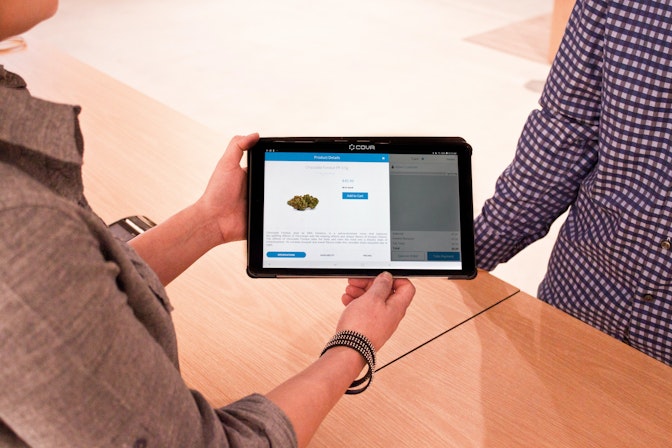Are you seeking an online business opportunity? Dropshipping might be the way to go.
The dropshipping market is expected to nearly double to $476.1 billion by 2026, from $243.42 billion in 2023. This growth suggests a promising future for aspiring ecommerce entrepreneurs.
What is dropshipping, and how does it work? This guide covers everything you need to know to launch your own dropshipping business.



What is dropshipping?
Dropshipping is an ecommerce strategy where you sell products on your website without having them in stock. Instead, when a customer places an order, you forward it to a supplier or manufacturer. They then ship the product directly to your customer. In this setup, you act as the intermediary between your customer and the supplier.
Dropshipping is great for entrepreneurs because running a store doesn’t demand as much operational capital as the traditional retail model. You don’t have to open a brick-and-mortar store, hire employees, pay overhead, or stock products. Instead, you open an online store and buy from suppliers who already have products and warehouse space.
→ Click Here to Launch Your Online Business with Shopify
What is a dropshipper?
A dropshipper is an individual or company that sells products online without actually having them in stock. Instead of keeping a warehouse full of items, they buy the product from a third party whenever a customer orders it. This third party also takes care of shipping the item directly to the customer.
Dropshipping means the heavy lifting—like storing goods and sending orders—is done by someone else. So, whether it’s just one person running their online store or a whole team, the dropshipping approach works the same. You sell items without the need to handle or store them yourself.
How does dropshipping work?
Dropshipping is essentially a hands-off approach to selling products online. You set up a customer-facing store and leave the remaining duties to a supplier.
There are two main ways to adopt the dropshipping business model:
Approach 1: Finding suppliers yourself
This approach involves searching for suppliers by yourself. You can use online databases like AliExpress, Worldwide Brands, or SaleHoo. These platforms have lists of wholesale suppliers from North America and beyond.
You choose the suppliers you want to work with, select their products, and then add those products to your online store. It’s a bit more hands-on, as you’re directly picking and managing your suppliers.
Approach 2: Using a supplier-connected app
The second approach is more streamlined. You use an app, like DSers on Shopify, that connects you to a network of suppliers. This saves you the time of finding suppliers individually.
With DSers, you can easily browse products on AliExpress. When you find something that fits your store, you can add it with a click. After a customer places an order, you process it through the DSers app.
The app automates much of the dropshipping process. You just need to verify the order details and confirm. The supplier from AliExpress then ships the product directly to your customer.
This dropshipping business model is pretty straightforward. But remember, it’s not a shortcut to instant wealth. Like any ecommerce business, it needs hard work and dedication to grow. If you do it right, dropshipping can become a reliable way to handle orders and shipping for your growing ecommerce store.
Benefits of dropshipping
1. Easy to set up
You don’t need prior business experience to start a dropshipping business. If you take some time to learn the basics, you can quickly get your business off the ground, picking up more knowledge as you go.
For instance, you don’t need a warehouse to store products or a large team to manage operations. Nor do you have to worry about stocking or shipping. With dropshipping, your inventory management is entirely online, making the process simpler and more manageable.
2. Low overhead costs
You can run an entire business right from your laptop, and you don’t need to make any high-level investments. Your largest expense will be advertising, which is a budget you can scale as your store gains more traction. Even as your business grows, your costs will be fairly low—especially when compared to traditional business expenses.
3. Location independence
One of the biggest perks of dropshipping is that you can run your business from anywhere. Whether you’re at home, in a coffee shop, or traveling, you can manage your store. It’s perfect for entrepreneurs who want a business that fits their lifestyle.
4. Easier to test
Want to try selling a new product but not sure if it’ll be a hit? Dropshipping lowers the risk. You don’t have to buy a bunch of stock upfront. Just list the product and see how it does. If it sells well, great! If not, you can easily remove it from your store without losing much.
5. Strong supplier network
Dropshipping opens doors to forming strong relationships with suppliers. These connections can be invaluable for future business ventures. Imagine you want to start a new product line or a completely different business. Having established supplier relationships means you have a network ready to support your new ventures.
Disadvantages of dropshipping
1. Low profit margins
Low margins are a big challenge for dropshipping companies in competitive markets. Since it’s relatively easy and inexpensive to start a dropshipping store, lots of businesses enter the market and sell their products at very low prices to attract customers.
Fortunately, you can tackle this issue by differentiating your dropshipping store. Focus on aspects that go beyond price, like offering exceptional customer service, creating a strong brand identity, or curating a unique product selection.
2. Shipping complications
When you run a dropshipping store with multiple suppliers, you’ll face some shipping challenges. This is because you don’t have control over the supply chain in the dropshipping model.
Imagine a customer orders three different items, and each one comes from a different supplier. You’ll end up with three separate shipping costs, one for each item. Usually, it’s not a good idea to make the customer pay all these extra shipping fees. And even if you decide to charge for them, working out these costs automatically can be tricky.
3. Limited branding and customization
In dropshipping, you don’t get much say in how the products are made or look. The products are usually designed and branded by the dropshipping supplier, not you.
Sure, some suppliers might let you tweak the products a bit. But even then, they’re the ones in charge of the actual product. Want to change or add something? Often, you’ll need to order a bunch of them to make it work for the supplier, both practically and cost-wise. So if you’re aiming to create a unique brand or custom products, dropshipping can be limiting.
4. Supplier mishaps
Have you ever been blamed for something that wasn’t your fault but had to accept responsibility for it anyway?
Even the best dropshipping suppliers make mistakes fulfilling orders—mistakes for which you have to take responsibility and apologize. In addition, mediocre and low-quality suppliers will harm the customer experience via missing items, botched drop shipments, and packing or product quality issues, which can damage your business’s reputation.
Is dropshipping profitable?
With typical profit margins between 10% and 15%, it definitely can be. The key is to pick the right products and build strong relationships with suppliers.
How you approach dropshipping can vary. You can run it as a side hustle or turn it into a full-time business. Let’s break it down.
Dropshipping on the side
Thinking of a side hustle? Dropshipping fits the bill. It’s flexible enough that you don’t need to give up your day job. Many people run their dropshipping business alongside a main job that ensures a steady income. This approach allows you to venture into entrepreneurship with minimal risk..
Before you get started, make sure your employer is OK with you having a side business. Quick check: Look over your company’s policy on side jobs and any contracts you’ve signed. No conflict of interest? You’re set to start.
You won’t need to pour endless hours into dropshipping. A couple of hours each day can get you up and running. But, balance is key. If you’re swamped with your regular job, squeezing in time for dropshipping might be a bit of a stretch. It’s about finding the right rhythm for your lifestyle.
Dropshipping full-time
Ready to go big? Dropshipping can also be your main gig. Start small, build your customer base, and gradually increase your sales. When the time feels right, you can switch from doing it part time to running a 9-to-5 dropshipping operation. Sure, it’s more work, but the rewards can be pretty sweet.
A solid dropshipping business can even feel like you’re earning passively. And the best part? You’re not stuck offering one thing. If you want to, you can explore other side hustles while managing your full-time dropshipping store.
Feeling unsure? Many successful dropshippers started just where you are now. You don’t need a ton of money or a business degree to make it work. What you do need is a solid strategy, a bit of dedication, and the willingness to learn as you go.
Is dropshipping legal?
Yes, dropshipping is legal. Many global retailers use this ecommerce fulfillment model to sell products without inventory. Just like most physical stores don’t manufacture their own products, dropshipping applies the same principle to online businesses. Retailers select and sell products from various suppliers without manufacturing them.
How much do I need to invest to start dropshipping?
It’s hard to say exactly how much you need to invest to start a dropshipping business. The costs can vary. However, every dropshipping business will need to spend money on a few essentials. You’ll need to buy a domain name and set up an ecommerce website for your online store. Also, you’ll have to budget for online marketing to attract customers. For more details on what these expenses might look like, have a look at our guide on dropshipping startup costs.
Dropshipping and the customer experience
You’ve bought products online hundreds of times before, but you’ve probably never thought about the experience. It’s second nature for consumers. As a customer, you don’t need to think about it, but as a retailer, you absolutely should.
Retailers can learn a lot by thinking about the ideal customer experience of ordering from a store. This may seem obvious, but if there are any snags in the customer experience, it could spell trouble for you as a retailer. It’s important to know what your buyers expect.
Let’s pretend you have a business called Fancy Water Bottles, a site called FancyWaterBottles.com, and a wholesaler called Water Bottles Worldwide. Here’s what the ordering process would look like from the customer’s perspective:
- Customer A places an order for a water bottle on FancyWaterBottles.com and immediately receives an email confirmation of the purchase.
- After a few hours and up to a couple of days, Customer A receives a notification that their order has shipped. The notification includes tracking information, so Customer A knows exactly where their package is while en route.
- Customer A receives the water bottle.
It’s the same process you go through each time you purchase something online, and there are two important aspects of this experience.
First, it’s simple. All the customer has to do is order the product and pay for it. Everything else, like an order confirmation email and tracking information, is handed to them on a silver platter.
Second: The buying experience is extremely convenient in every way. An online purchase takes just minutes, and customers can browse any retailer’s site at their leisure. And if all goes well, the customer won’t even have to interact with anyone. It takes the minimum amount of effort to achieve the desired result of getting a product.
This experience is a lot like buying a water bottle at a big box store and using the self-checkout. It’s a no-fuss process that doesn’t present any problems. This is a big reason why people buy online in the first place, so your storefront has to give your customers that same level of convenience.
Last but not least, the customer never has to learn that any other parties besides the retailer are involved. Think about it. When you buy something online, you think, “I bought a water bottle from Fancy Water Bottles.” You don’t consider where the retailer got the product or who might be shipping your order.
This is how the dropshipping process ideally should look from the customer’s point of view.
Getting started with dropshipping
Dropshipping may sound like a complicated puzzle, but once you learn how to do it, it’s a smooth process for everyone involved. You, the dropshipping merchant, can do everything remotely and never even touch a single product.
Remember that you don’t need any business experience to open a dropshipping storefront (though it doesn’t hurt). Many budding entrepreneurs don’t ever chase their dreams because they believe they need an MBA or years’ worth of experience. This isn’t the case. One of the benefits of dropshipping is that you can learn how to do it as you go.
There also are numerous resources that help make dropshipping easy. You can have absolutely zero business experience and still make a profit.
Here are the steps required to start a dropshipping business:
- Select a dropshipping business idea.
- Conduct market research.
- Find a dropshipping supplier.
- Set up your ecommerce store.
- Decide the legal structure of your business.
- Organize your finances.
- Launch and market your dropshipping store.
Your dropshipping business may be small at first, but all successful entrepreneurs have to start somewhere. Draw up a strategic plan, evaluate opportunities and costs, and make your business dream happen.
What is dropshipping FAQ
What are some alternatives to dropshipping?
Looking for other ways to run your online store? Third-party fulfillment is one. Buy your products wholesale, then have a service take care of storing, packing, and shipping them. It’s great for keeping an eye on quality and offering special deals.
Another path is making your own branded products. You can either spice up dropshipped items with unique packaging or go big by manufacturing your own products. This way, your brand gets exposure and customers remember you.
Or, consider affiliate marketing—you promote products, then earn a commission for every sale through your link. No selling or shipping hassles, just promoting and earning.
Even with these options, dropshipping often wins out. It’s simple, low-cost to start, and highly flexible—perfect if you’re new to ecommerce or want to try out business ideas with little risk.
What’s the difference between dropshipping and retail arbitrage?
In dropshipping, you sell products in your online store without actually stocking them. When someone buys from you, a supplier ships the product directly to the customer.
On the other hand, retail arbitrage is about buying products from retail stores and then selling them online at a higher price. So, when someone buys from your online store, you go out, buy the item from a retailer, and then ship it to the customer yourself.
Both are business models for selling online, but they handle inventory and shipping very differently.
Which platform is best for dropshipping?
Shopify is the best platform for dropshipping beginners. It’s user-friendly and integrates seamlessly with major platforms like Amazon and AliExpress. This integration simplifies order fulfillment and shipping, making it easier to manage your business.





